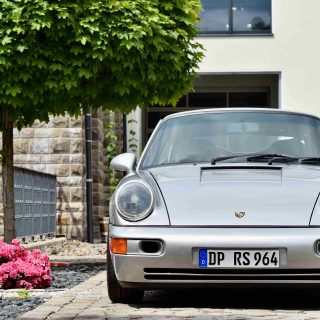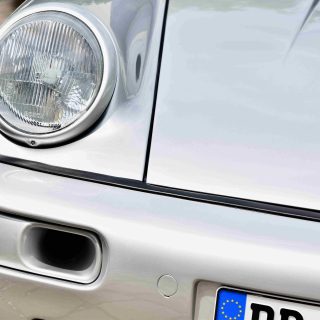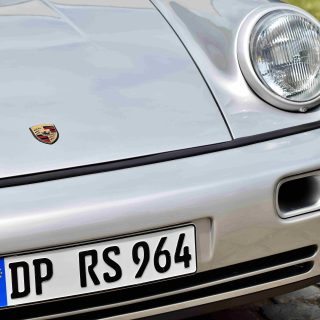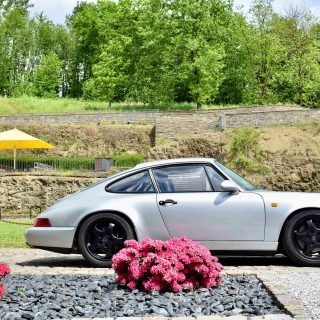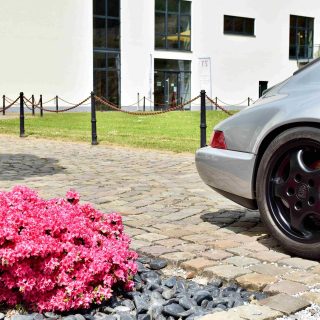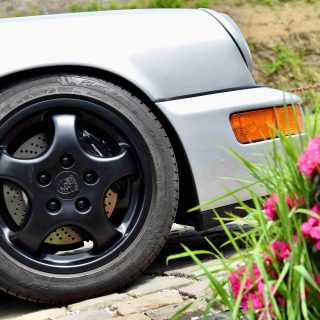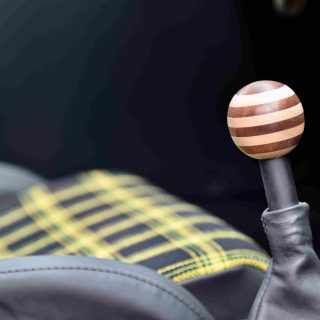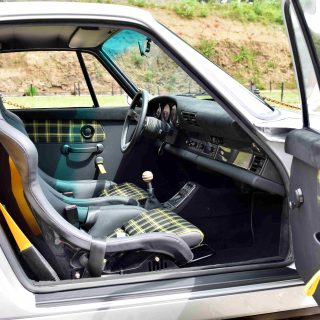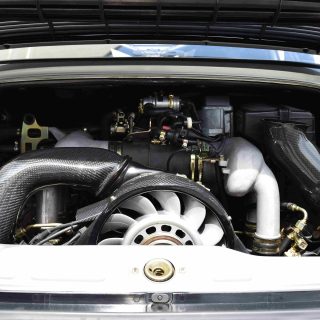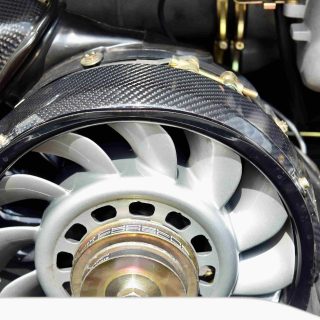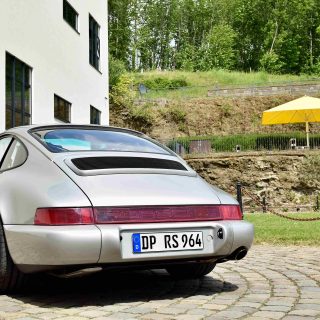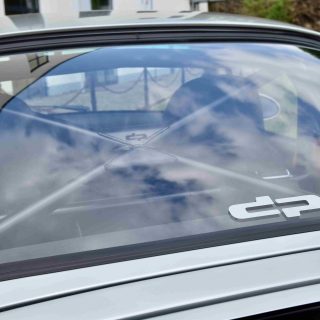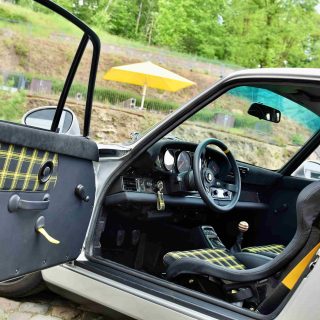The Brazilian Ride
1990 Porsche 911 (Type 964) Carrera 2 Coupé, refreshtoration by dp Motorsports in the look of the Carrera RS
The Brazilian Ride
Brazilian customer, original Swabian basic concept, Rhenish implementation: this 1990 Porsche 911 (type 964) Carrera 2 Coupé with bonds from the RS deserves the title “remarkably multinational”.
Patrick Zimmermann and his sports car connoisseurs from dp Motorsports staged it as part of a “refreshment”. This combined terminology usually conceals the partial restoration of not quite comprehensive dimensions. The result deviates from the now historical model of 1992 in various details. But it is precisely this subtle difference that is intended, as it conveys a beneficial degree of individuality. This is also in demand in Brazil, and not only that: the air conditioning system played a role that should not be underestimated, which is actually only logical. Not in this case, because the classic refrigeration compressor in the engine chamber was overlooked when the base vehicle was purchased in northern Germany. It was missing, and for a (not that) good reason: it was an online purchase without a prior visit on site…
The headlines:
Refined: Quotations from the famous Carrera RS in 1992 upgrade the C2 Coupé delivered in 1990.
Delivered later: Dynamics thanks to original magnesium wheels, just like the original three decades ago.
Retrofitted: electrically operated air conditioning creates a sense of well-being in the Brazilian ambient air.
Overath-Immekeppel, Germany. The latest vehicle construction project by the nine-eleven specialists from dp Motorsports is in many ways a wanderer between two worlds. On the one hand, it is a reference to a special series produced more than 30 years ago in Stuttgart-Zuffenhausen, but in the details deviations from the original – individualisations – must be appreciated. In addition, the partial restoration of the Carrera 2 Coupé built in 1990 was carried out on behalf of a new Brazilian customer. After initial online research, this was sent to the traditional Rhineland company by email. He didn’t own a basic vehicle, so his ideas were all the more specific. He wanted to embark on a special tour of Germany: the Porsche Museum, the Nürburgring, and finally a home visit to Alois Ruf. The befitting means of transport should be a clone of the 964 generation Carrera 2 introduced in 1992. In the internet-based search for a good used vehicle, dp Motorsports was to provide advisory support as the later executing company. Finally, a silver copy was found in northern Germany, purchased and picked up by a dp employee. Equipped with a clipboard as a precaution, he sat on a passenger train and wanted to write down first impressions of the transfer journey on the way back. This could have shortened the further procedure. The most important finding: The C2 bought online did not have air conditioning – not the best prerequisite for later export to South America.
Patrick Zimmermann was certain that the classic air conditioning compressor in the engine compartment could only be retrofitted at considerable expense. An electrical system of english origin was the economically more sensible solution, especially since the towing power at the expense of the engine would be eliminated with an aftermarket variant. In addition to eliminating the corresponding belt drive, part of the weight concentration would also move forward towards the front axle. The other measures: more of a refreshtoration – a work-up in defined areas – rather than a frame-off restoration. An original aluminum front hood from the Porsche spare parts program, a carbon trunk lid, the RS rear apron and clear, transparent lightweight glass – apart from the windscreen: These are the styling details on the exterior, which were allowed to retain the factory exterior color silver. The Carrera 2 (although it was retrofitted after the photo shoot) gets a large part of its charm from its original magnesium wheels in traditional 17-inch dimensions. This means that the Carrera 2 comes with two sets of wheels, the older one, including the somewhat dated original tires, was part of the machine when it was purchased. “Magnesium wheels still exist,” reports Patrick Zimmermann, “even if the first shot today doesn’t necessarily hit the mark.” What does he mean by that? “Well,” explains the experienced practitioner, “of course we know that magnesium wheels that are more than 30 years old have to be checked and professionally refurbished. Above all, they should be sealed to preserve their basic substance. But one is surprised when old stocks are delivered for overhaul that are actually not suitable for this – improper maintenance or some weather influences lead to magnesium corrosion, especially on the back, on the flat contact surface of the wheel hub. A lot eats away, you often look at open, large-pored material – and you can’t put a spatula on it again and again. That was also the crux of the matter, why we looked at the selection quite critically”.
Only the second – or was it the third? – a set of used original magnesium wheels had the potential to be used for more sporty projects in the future. The tyres: new Michelin semisicks of the state-of-the-art “PilotSport Cup” specification, which meet the dynamic demands of the one-piece suit. Of course, the overall appearance also includes a sports suspension with visible lowering. KW delivers it, in a clubsports tuning manner: a visual supplement to the appearance inspired by the Carrera RS. The interior has largely adapted to the outside conditions: Recaro “Pole Position” bucket seats with individual upholstery, carbon elements, clubsports roll bar from the repertoire of dp Motorsports, Momo three-spoke steering wheel of the type “M07″, black leather interior with yellow/black/green checkered textile, plus a set of velor carpets in RS specification: these are the main features inside the car. The highlight par excellence remains largely invisible, and that is intentional. The hi-fi system from “Dr. Boom” makes you hear impressively. You can’t see much of it, the inclined observer will look in vain for the speakers or an amplifier. But both are there, for sure. The six-cylinder boxer in the rear compartment, which has been enlarged from 3.6 to 3.8 liters displacement and owes its increased breathing air to a larger throttle valve, also produces a harmonious sound that is appropriate to the species. An engine with increased horsepower and maximum torque (318 hp, 361 Newton meters) naturally requires more active driving safety. The brakes that had been added to the 993 generation had to be replaced with the original equipment from the 964 Carrera RS. Now the view through the rim arms looks almost the same as it did when the product was presented in 1992. The vehicle height also corresponds to that of the former sports model, caused by a KW thread road sports suspension in clubsports tuning. H&R contributed the stabilizers to the overall picture: an extraordinary canon of two market leaders in this sector.
The retrofitted locking differential in the five-speed manual transmission of the type G50 ensures optimal propulsion from the middle of the curve on, the shift travel reduction ensures precise gear changes and ensures that the rear-wheel drive vehicle stays “under power” in every situation – and thus stays on track. That should also remain so in Brazil when the RS quotation has been finally delivered to South America. Patrick Zimmermann takes stock: “A cool project, perhaps not quite as complex as a backdate nine-eleven and still exclusive enough to make it stand out in a positive way.” The initially missing air conditioning system is now on board, so the motto is: ” The Brazilian Ride”. Quite freely translated: just the real thing in the birthplace of the great Ayrton Senna da Silva.
Responsible for the content: netzwerkeins GmbH, Carsten Krome
tech data – the technical documentation in all relevant details
Vehicle type: 1990 Porsche 911 (Type 964) Carrera 2 Coupé, refraction by dp Motorsport in the look of the Carrera RS
Model year: 1990 (L program)
Body (standard on delivery from the factory): 2-door, 2+2-seater, self-supporting coupé body made of sheet steel hot-dip galvanized on both sides; special conversions: RS aluminum front hood, RS rear apron, carbon trunk lid, clear plexiglass instead of the original glazing (except for the windshield); dry ice treatment of the vehicle floor carried out by dp Motorsports
Engine (factory delivery): air-cooled six-cylinder boxer type M64/01; two valves per cylinder; one camshaft per cylinder bank (ohc); double chain drive; special conversions: displacement increase to 3,800 ccm; Dr. Schrick camshaft set; enlarged throttle valve system
Mixture preparation (factory delivery): via Bosch Motronic 2.1 electronically controlled, sequential injection
Ignition (factory delivery): map-controlled dual ignition via Bosch DME
Engine power (new): 318 hp
maximum torque: 361 Nm
Power transmission (new): five-speed manual transmission type G50 with limited-slip differential; shift travel reduction type 964 Carrera RS
Brake system (new): aluminum four-piston fixed calipers, type 964 Carrera RS; ventilated steel discs
Wheel suspension (new, front): individually on light alloy wishbones and KW clubsports struts; H&R stabilizers; wheel spacers; transverse support between the front spring strut towers
Wheel suspension (new, rear): individually on light metal trailing arms and KW clubsports struts; H&R stabilizers; wheel spacers
Wheels & tires (new): retrofitted magnesium wheels type 964 Carrera RS (front axle: 225/45 ZR 17 to 7.5 x 17 ET 55 Cup 1 design 965.363.124.15 with hub cap; rear axle: 255/40 ZR 17 to 9, 0 x 17 ET 55 Cup 1 design 965.362.128.10 with hub cap
Interior: design concept in black leather with black/yellow/green checked fabric; Recaro profile bucket seats type “Pole Position”; clubsports roll bar by dp Motorsports; Momo steering wheel type M07; RS velor carpet; sight carbon bezels; partially hidden sound system; electric air conditioning upgraded; “Liteblox” battery in the luggage compartment
Curb weight according to DIN 70020 (factory delivery): 1.350 kg
Top speed: 260 km/h (factory delivery)
Acceleration (factory delivery, 0 – 100 km/h): 5.7 sec.
